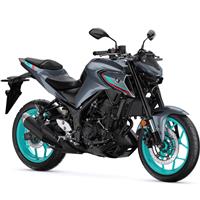 Yamaha MT-03 - Owner's Manual > Checking the spark plug
Yamaha MT-03 - Owner's Manual > Checking the spark plug
The spark plug is an important engine component, which is easy to check.
Since heat and deposits will cause any spark plug to slowly erode, the spark plug should be removed and checked in accordance with the periodic maintenance and lubrication chart. In addition, the condition of the spark plug can reveal the condition of the engine.
To remove the spark plug

- Spark plug cap
- Spark plug wrench
1. Remove the spark plug cap.
2. Remove the spark plug as shown, with the spark plug wrench included in the owner's tool kit.
To check the spark plug
1. Check that the porcelain insulator around the center electrode of the spark plug is a medium-to-light tan (the ideal color when the vehicle is ridden normally).
NOTE: If the spark plug shows a distinctly different color, the engine could be defective.
Do not attempt to diagnose such problems yourself. Instead, have a Yamaha dealer check the vehicle.
2. Check the spark plug for electrode erosion and excessive carbon or other deposits, and replace it if necessary.
Specified spark plug: CR7E (NGK)
To install the spark plug
1. Measure the spark plug gap with a wire thickness gauge and, if necessary, adjust the gap to specification.
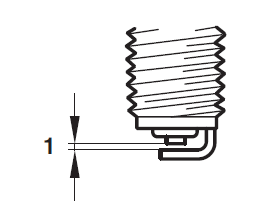
- Spark plug gap
Spark plug gap: 0.7-0.8 mm (0.028-0.032 in)
2. Clean the surface of the spark plug gasket and its mating surface, and then wipe off any grime from the spark plug threads.
3. Install the spark plug with the spark plug wrench, and then tighten it to the specified torque.
Tightening torque:
Spark plug: 12.5 Nm (1.25 m-kgf, 9.0 ft-lbf)
NOTE: If a torque wrench is not available when installing a spark plug, a good estimate of the correct torque is 1/4- 1/2 turn past finger tight. However, the spark plug should be tightened to the specified torque as soon as possible.
4. Install the spark plug cap.
Engine oil and oil filter element
The engine oil level should be checked before each ride. In addition, the oil must be changed and the oil filter element replaced at the intervals specified in the periodic maintenance and lubrication chart.
To check the engine oil level
1. Place the vehicle on a level surface and hold it in an upright position.
NOTE: Make sure that the vehicle is positioned straight up when checking the oil level. A slight tilt to the side can result in a false reading.
2. Start the engine, warm it up for 10-15 minutes, let it continue to idle for 20-30 seconds, and then turn it off.
3. Wait a few minutes until the oil settles, remove the oil filler cap, wipe the dipstick clean, insert it back into the oil filler hole (without screwing it in), and then remove it again to check the oil level.
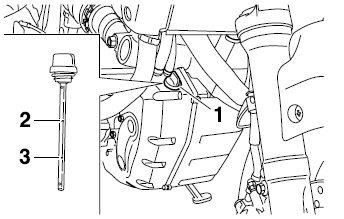
- Engine oil filler cap
- Maximum level mark
- Minimum level mark
WARNING
The exhaust pipes are very hot during and following operation. To prevent burns when removing the oil filler cap, use extra care not to touch the exhaust pipes.
NOTE:
- The engine oil tank is located in front of the frame.
- The engine oil should be between the minimum and maximum level marks.
CAUTION: Do not operate the vehicle until you know that the engine oil level is sufficient.
WARNING
Never remove the engine oil tank cap after high-speed operation, otherwise hot engine oil could spout out and cause damage or injury.
Always let the engine oil cool down sufficiently before removing the oil tank cap.
4. If the engine oil is below the minimum level mark, add sufficient oil of the recommended type to raise it to the correct level.
5. Install the oil filler cap.
To change the engine oil (with or without oil filter element replacement)
1. Start the engine, warm it up for several minutes, and then turn it off.
2. Place the motorcycle on its side stand, then place an oil pan under the oil tank and another under the engine to collect the used oil.
3. Remove the engine oil filler cap and the drain bolt to drain the oil from the crankcase.
4. Remove the drain bolt to drain the oil from the oil tank.
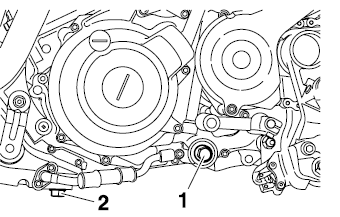
- Engine oil crankcase drain bolt
- Engine oil tank drain bolt
5. Remove the oil filter element drain bolt to drain the oil from the oil filter element.
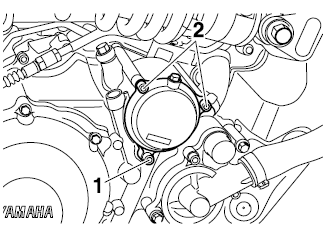
- Engine oil filter element drain bolt
- Oil filter element cover bolts
NOTE: Skip steps 6-8 if the oil filter element is not being replaced.
6. Remove the oil filter element cover by removing the bolts.
7. Remove and replace the oil filter element and O-rings.
8. Install the oil filter element cover by installing the bolts and the oil filter element drain bolt, then tightening them to the specified torques.
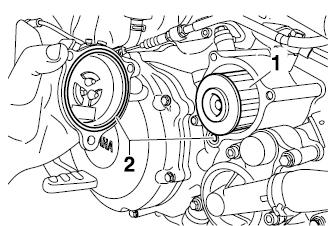
- Engine oil filter element
- O-rings
Tightening torques:
Oil filter element cover bolt: 10 Nm (1.0 m-kgf, 7.2 ft-lbf)
Oil filter element drain bolt: 10 Nm (1.0 m-kgf, 7.2 ft-lbf)
NOTE: Make sure that the O-rings are properly seated.
9. Install the oil drain bolts, and then tighten them to the specified torques.
Tightening torques:
Engine oil drain bolt (crankcase): 30 Nm (3.0 m-kgf, 22 ft-lbf)
Engine oil drain bolt (oil tank): 30 Nm (3.0 m-kgf, 22 ft-lbf)
10. Add the specified amount of the recommended engine oil, and then install and tighten the oil filler cap.
CAUTION: The engine oil tank must be filled in 2 steps. First, fill the engine oil tank with 2.0 L (2.11 US qt) (1.75 Imp.qt) of the recommended engine oil.
Then, start the engine, race it 5 or 6 times, turn it off, and then add the remainder of the engine oil.
Oil quantity:
Without oil filter element replacement: 3.0 L (3.17 US qt) (2.64 Imp.qt)
With oil filter element replacement: 3.1 L (3.28 US qt) (2.72 Imp.qt)
CAUTION:
- In order to prevent clutch slippage (since the engine oil also lubricates the clutch), do not mix any chemical additives. Do not use oils with a diesel specification of "CD" or oils of a higher quality than specified. In addition, do not use oils labeled "ENERGY CONSERVING II" or higher.
- Make sure that no foreign material enters the crankcase.
11. Start the engine, and then let it idle for several minutes while checking it for oil leakage. If oil is leaking, immediately turn the engine off and check for the cause.
12. Turn the engine off, and then check the oil level and correct it if necessary.
Coolant
The coolant level should be checked before each ride. In addition, the coolant must be changed at the intervals specified in the periodic maintenance and lubrication chart.
To check the coolant level
1. Place the vehicle on a level surface and hold it in an upright position.
NOTE:
- The coolant level must be checked on a cold engine since the level varies with engine temperature.
- Make sure that the vehicle is positioned straight up when checking the coolant level. A slight tilt to the side can result in a false reading.
2. Check the coolant level in the coolant reservoir.
NOTE: The coolant should be between the minimum and maximum level marks.

- Coolant reservoir
- Maximum level mark
- Minimum level mark
- Reservoir cap
3. If the coolant is at or below the minimum level mark, open the reservoir cap, add coolant to the maximum level mark, and then close the reservoir cap.
Coolant reservoir capacity: 0.25 L (0.26 US qt) (0.22 Imp.qt)
CAUTION:
- If coolant is not available, use distilled water or soft tap water instead. Do not use hard water or salt water since it is harmful to the engine.
- If water has been used instead of coolant, replace it with coolant as soon as possible, otherwise the engine may not be sufficiently cooled and the cooling system will not be protected against frost and corrosion.
- If water has been added to the coolant, have a Yamaha dealer check the antifreeze content of the coolant as soon as possible, otherwise the effectiveness of the coolant will be reduced.
WARNING
Never attempt to remove the radiator cap when the engine is hot.
NOTE:
- The radiator fan is automatically switched on or off according to the coolant temperature in the radiator.
- If the engine overheats, see page 3-4 for further instructions.
Changing the coolant
WARNING
Never attempt to remove the radiator cap when the engine is hot.
The coolant must be changed at the intervals specified in the periodic maintenance and lubrication chart.
Have a Yamaha dealer change the coolant.
Replacing the air filter element and cleaning the check hoses
The air filter element should be replaced at the intervals specified in the periodic maintenance and lubrication chart. Replace the air filter element more frequently if you are riding in unusually wet or dusty areas. In addition, the air filter check hoses must be frequently checked and cleaned if necessary.
To replace the air filter element

- Air filter case
- Screws
1. Remove the air filter case cover by removing the screws.
2. Pull the air filter element out.
3. Insert a new air filter element into the air filter case as shown.
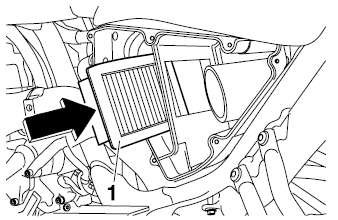
- Air filter element
CAUTION:
- Make sure that the air filter element is properly seated in the air filter case.
- The engine should never be operated without the air filter element installed, otherwise the piston(s) and/or cylinder(s) may become excessively worn.
4. Install the air filter case cover by installing the screws.
To clean the air filter check hoses

- Air filter check hose (case cover)
1. Check the hoses shown for accumulated dirt, water or oil.
2. If dirt, water or oil is visible, remove the hose, clean it, and then install it in its original position.
See also:
 Yamaha MT-03 - Owner's Manual > Owner's tool kit
Yamaha MT-03 - Owner's Manual > Owner's tool kit
Owner's tool kit Fastening strap The owner's tool kit is located on the bottom of the passenger seat and it held in place with an O-ring.
 Yamaha MT-03 - Owner's Manual > Adjusting the engine idling speed
Yamaha MT-03 - Owner's Manual > Adjusting the engine idling speed
Idle adjusting screw The engine idling speed must be checked and, if necessary, adjusted as follows at the intervals specified in the periodic maintenance and lubrication chart.

 Benelli Imperiale 400
Benelli Imperiale 400 BMW F900XR
BMW F900XR Honda CB500X
Honda CB500X KTM 390 Adventure
KTM 390 Adventure Triumph Street Triple S
Triumph Street Triple S Yamaha MT-03
Yamaha MT-03 Kawasaki Z400
Kawasaki Z400 Triumph Street Triple S
Triumph Street Triple S Yamaha MT-03
Yamaha MT-03